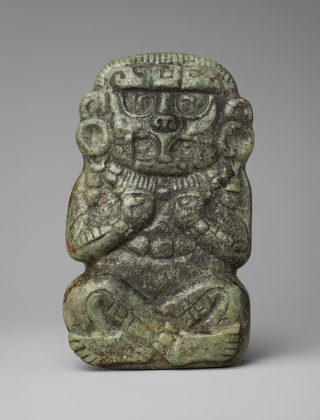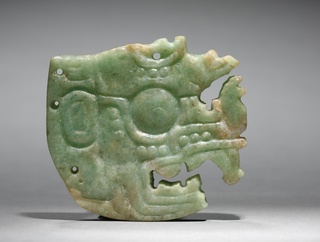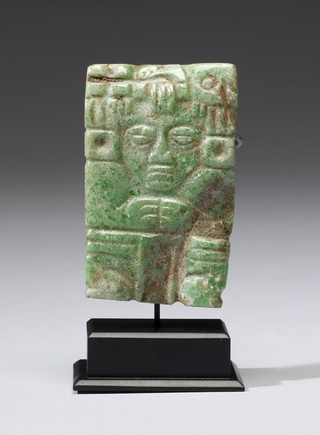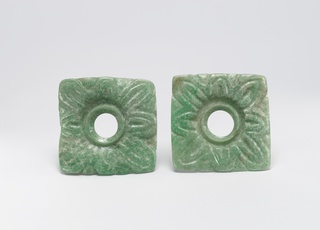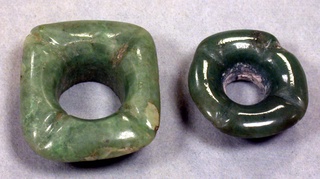Maya Deities and Nobles in Living Jade
By Reina Gattuso•July 2022•15 Minute Read

Unknown, Crown Ornament (Hu’unal), 250-900. Cleveland Museum of Art. In Mesoamerica, elites wore jade on their royal garb as a connection to the spiritual realm.
Ancient Maya people revered jade as a living stone that embodied sacred water, breath, and regeneration. Representations of deities and nobles in jade reveal the ancient Maya cosmovision. To understand these artifacts in context, modern people must question the colonial legacy in Mesoamerican archaeology.
Introduction
The ancient people that archaeologists call Maya built complex city-states in what is now southern Mexico, Guatemala, Honduras, Belize, and Nicaragua. They built some of their largest monuments during the so-called classic period, from 250 to 900 CE.1
The many groups we now call Maya would not have considered themselves to belong to a common identity. They spoke different (though related) languages, and frequently conquered each other’s cities in bids to become regional power brokers.2
However, ancient peoples of the region were united by a shared view of the universe, or cosmovision.3 Maya peoples developed a complex astronomical system, calendar, and writing system. They worshiped similar deities, whom elites and semi-divine rulers had special access to. They revered maize, their foundational crop. And the Maya esteemed the most precious of Mesoamerican materials: luminous, life-giving jade.
Ancient Maya peoples considered jade a living stone. They associated its vibrant green surface with water, corn, and sacred breath — and thus nobility and divinity. Jade artifacts, ranging from deity figurines to elite adornments, offer insights into ancient Maya peoples’ cosmovision.
Mesoamerican Archaeology and Colonization
All of the objects featured in this essay are currently in the collections of U.S. museums. Most have passed through multiple white owners’ hands. None of them have publicly available information detailing where they were found and by whom. It’s thus difficult to discern how local Maya people may have related to them.
The continued alienation of these objects from their cultures reflects the colonial origins of archaeology, which continues to be a white-dominated field.4 To understand the objects of pre-Columbian people—including Maya jade objects—we must understand how European colonization harmed American Indigenous peoples, and shaped the field of archaeology.
Historians estimate that within the first decade of colonization, Spanish colonizers and their diseases killed upwards of 90% of the population in the Maya-ruled Yucatán Peninsula.5 Spanish colonizers murdered, stole the land of, and forcefully converted ancient Maya people. Catholic priests burned Maya codices, texts written on bark paper. Only four Maya codices exist today.6 Postcolonial states also committed violence against Maya peoples, including the Guatemalan genocide.7
While colonization resulted in a devastating loss of life and culture, it’s incorrect to say — as many archaeologists have — that the Maya were “lost” after about 1000 CE.8 In fact, due to fierce resistance, some Maya cities remained independent of the Spanish until 1697.9 Contemporary Maya people relate to their ancient history, and to the category of “Maya” itself, in diverse ways.10 Many draw on their cultural heritage in struggles for social justice and self-determination.11
Surviving codices, architecture, oral histories, and art — including objects in jade — paint a vibrant picture of the ancient Maya world.
Jade in Maya Geology and Cosmology
Olmec artists made the earliest jade objects in Mesoamerica, starting around 900 BCE. Maya artists followed suit.12 Artists throughout Mesoamerica and Central America, including the Maya, frequently reworked jade objects from older cultures, and then passed them down as heirlooms.13
Mexica people, the ruling class of what we now call the Aztec Empire, also valued jade. Indeed, when colonizer Hernán Cortés first met Moctezuma II, the ruler offered him a gift of jade, saying it was worth “two loads of gold” in contemporary measurement.14
Social and Geologic Jade
The ancient Maya actually used several kinds of green stone that archaeologists group under the category “social” or “cultural” jade. This includes serpentinite, amazonite, quartz, and malachite. Of these, jadeite is the only stone geologists call jade. Jadeite is much harder and more durable than other green stones.15
The only known major jadeite deposit in Mesoamerica is located in the Montagua fault of what is now Guatemala. Maya peoples developed elaborate trade networks in order to obtain the mineral.16
Jade Workers
The Maya favored brilliant, saturated green stones. Archaeologists call these colors “apple green” and “imperial green,” since the latter color was vital to Maya royal regalia. Maya artists often cracked open the extremely hard rock to find the most vibrant parts for their artwork.17
Mesoamerican artists hit jade with other rocks to shape it. They cut it with saws made from flint blades or knotted fibers bound with ground stone, then polished the finished shape. Jade is as hard as steel, so this process took an incredible amount of time, skill, and patience.18
Vibrant green jade was important to Maya conceptions of nobility. The creators of this pendant chose to use the greenest part of the stone for the noble’s upper body, demonstrating their high esteem for the color.19
Jade in Maya Cosmovision
Maya people valued jade because it was rare and because artists worked it with immense skill. But the brilliant blue-green stone also held a deeper meaning, associated with fertility, divinity, nobility, and life itself.
Ancient Maya cosmovision was structured around the four cardinal directions with the tree of life as the sacred center. The tree of life formed a vertical axis connecting the terrestrial world with the underworld and heavens.20 Maya communities revered powerful divinities including the Principal Bird Deity, the Moon Goddess, and the maize deity or deities.21
The Yucatec Maya word yax means the colors green and blue. Yax represents both the air, including the vivid green feathers of the quetzal bird, and cool, lifegiving water. The word also represents maize, the Maya staple crop. The maize god embodies cycles of germination, growth, death, and rebirth.22
The Mexica believed that jade emitted a fresh, moist vapor that made plants around it grow even greener.23 The Maya believed jade was water and breath in solid form.24 The Spanish documented a 16th century Maya death ritual in which nobles’ attendants rubbed “precious stone” on a dying noble’s mouth to capture “the breath, soul, or spirit.”25 Archaeologists theorize that water droplets from breath condensing on jade’s surface inspired this association with moisture.26 Jade didn’t just symbolize fertility and life force to the ancient Maya—it embodied these qualities.
Deities
Jade’s sacredness made it the ideal medium for Maya carvings of deities. The iconography for both deities and nobles typically included ear flares, necklaces, pendants, and other jade ornaments.
Archaeologists call this figure the Principal Bird Deity. The figure represents either a humanized version of the god or a human wearing the god’s mask. The deity is associated with the earth’s riches, including green corn fields, emerald quetzal feathers, and sacred jade.27
This figure is discolored, which is rare in a jade object. Archaeologists theorize people coated the figure with cinnabar pigment, and then burned it in a ritual. Cinnabar becomes mercury under heat and pressure, and mercury discolors jade. The red cinnabar likely symbolized blood sacrifice, while the ritual evoked death and rebirth.28
The Principal Bird Deity figure, like other Maya gods, wears heavy jade ornaments. This includes a necklace similar to the one above, which features jade beads and pendants, including a pendant of a figure that resembles the maize god.29
Maya rulers wore pendants of deities on their paper headbands. These pendants, called hu’unal, invoked rulers’ direct connection to the gods.
One hu’unal pendant, pictured here, included the face of the Principal Bird Deity, and the glyph meaning “paper.” This pendant likely evoked the headband’s material, and represented paper’s living essence. The pendant also references the first human king, whom the ancient Maya believed to be enthroned by the gods.30
When rulers wore hu’unal pendants, they proclaimed their connection to the gods who enthroned the first human king.31
Nobles
Jade depictions of the Maya ruling class reinforced kings’ and queens’ association with the gods. Rulers, like the deities they channeled, wore elaborate jade adornments decorated with images of gods. Nobles were often buried with ornate jade jewelry, sometimes including lifelike jade masks.
One ancient Maya ruler, Queen Tz’akbu Ajaw, was buried with an elaborate mask. Her husband, K’inich Janaab Pakal I of Palenque, was buried wearing a mask and jade ornaments totaling over three kilograms.32
Artists spent an enormous amount of time shaping each individual piece of jade so they would fit together perfectly. In K’inich Janaab Pakal’s mask, for example, the artists placed darker pieces of jade by the hairline and lighter shades near the cheekbones, to create shading. The jade masks ensured that rulers would become gods after death, resurrecting like the maize god.33
Artists also carved jade pendants representing nobles. The noble figure in the pendant seen above is carved with large ear flares, a spiritually potent form of jewelry.
Ancient Maya nobles used beads or sticks to keep the hollow flares in place in their earlobe holes. Polished jade emits a sonorous, metallic sound when struck. Ancient Maya people also believed that jade emitted perfumed breath. Ancient Maya people likely regarded these flower-shaped ear flares as living beings emitting sound, scent, and moisture. Wearing ear flares was thus a sacred sensory experience.34
The ancient Maya believed that holes, caves, and bodily orifices were passages into spiritual realms. In fact, the Mayan glyph for a common euphemism for death, “to enter/go on the road,” is a snake moving through an earflare. The flower petals carved on one set of ear flares point to the four cardinal directions. The hole at the center forms a portal or tree of life. Ear flares thus used the power of jade to transform the wearer into a sacred portal to the divine.35
Community Archaeology
Scholars and the general public continue to be fascinated with ancient Maya art and culture, including artifacts in jade. However, modern-day Maya peoples are often excluded from the profits of cultural tourism. “We realize that we have a great history, that we are held up as an example, and people make a lot of money off our name,” said Maya activist Alfaro Yam Canul to the Associated Press. “But that money never shows up in our communities.”36
Maya people have used the art of their ancient ancestors as potent symbols of resistance. The Zapatista Army of National Liberation, most of whom are Maya,37 often uses Maya symbols in their revolutionary iconography. These include maize38 and the caracol, or snail shell, which Zapatista leaders say represents the ancient Maya practice of blowing a conch shell to gather community.39 Maya diasporic organizations draw on ancient Maya cosmovisions as part of their vision of social justice.
Maya archaeologists, and some non-Maya, have sought to collaborate with Indigenous communities to recenter descendents’ relationships with ancient objects.40 Ancient Maya jade work elaborates a conception of the universe that remains culturally and politically potent for many descendant communities today.
Reina Gattuso is a content writer on the Curationist team, and an independent journalist covering gender and sexuality, arts and culture, and food. Her journalism connects analysis of structural inequality to everyday stories of community, creativity, and care. Her work has appeared at Atlas Obscura, The Washington Post, Teen Vogue, The Lily, POPSUGAR, and more. Reina has an MA in Arts and Aesthetics (cinema, performance, and visual studies) from Jawaharlal Nehru University in New Delhi, India, where her research focused on sexuality in Hindi film. She writes and teaches writing to high school students in New York City.
Citations
“Maya Civilization.” Wikipedia, https://en.wikipedia.org/wiki/Maya_civilization. Accessed 10 June 2022.
“Maya Civilization.”
“Maya Cosmovision.” Mayan League, https://www.mayanleague.org/maya-cosmovision. Accessed 29 April 2022.
White, William and Catherine Draycott. “Why the Whiteness of Archaeology is a Problem.” Sapiens, 7 July 2020, https://www.sapiens.org/archaeology/archaeology-diversity/. Accessed 29 April 2022. See also: Carruthers, William et al. “Special Issue: Inequality and Race in the Histories of Archaeology.” Bulletin of the History of Archaeology, 19 May 2021, https://www.archaeologybulletin.org/articles/10.5334/bha-660/. Accessed 29 April 2022.
“Spanish Conquest of Yucatán.” Wikipedia, https://en.wikipedia.org/wiki/Spanish_conquest_of_Yucatán. Accessed 24 June 2022. See also Alexander Koch et. al. “European colonisation of the Americas killed 10% of world population and caused global cooling.” The Conversation, 31 January 2019, https://theconversation.com/european-colonisation-of-the-americas-killed-10-of-world-population-and-caused-global-cooling-110549. Accessed 10 June 2022.
Zorich, Zach. “The Maya Codices.” Archaeology, Jan 2013, https://www.archaeology.org/issues/44-1211/features/maya-2012/305-groiler-dresden-codex. Accessed 24 June 2022.
United Nations Human Rights Office of the High Commissioner. “Guatemala: UN experts welcome court ruling that Ixil Mayans were victims of genocide and urge the State to prosecute and punish the perpetrators.” United Nations, 22 October 2018, https://www.ohchr.org/en/press-releases/2018/10/guatemala-un-experts-welcome-court-ruling-ixil-mayans-were-victims-genocide?LangID=E&NewsID=23746. Accessed 29 April 2022. See also: “Mexico apologises to Indigenous Maya people for historic abuses.” Al Jazeera, 4 May 2021, https://www.aljazeera.com/news/2021/5/4/terrible-abuse-mexico-apologises-to-indigenous-maya. Accessed 29 April 2022.
Leviathan, Richard M., Carlos Chan Espinosa, and Cristina Coc. “The Modern Maya and Recent History.” Expedition, vol. 54, no. 1, 2012, pp. 46 - 51, https://www.penn.museum/documents/publications/expedition/PDFs/54-1/The-Modern-Maya-and-Recent-History.pdf. Accessed 29 April 2022.
“Spanish Conquest of the Maya.” Wikipedia, https://en.wikipedia.org/wiki/Spanish_conquest_of_the_Maya. Accessed 29 April 2022.
Castillo Cocom, Juan. “Lost in Mayaland.” The Journal of Latin American Anthropology, vol. 9, no. 1, 2004, pp. 179-187. OSEA, http://osea-cite.org/class/readings/Castillo-Cocom_Lost_Mayaland.pdf. Accessed 29 April 2022. See also: Castillo Cocom, Juan Ariel. “Vulnerable identities: Maya Yucatec identities in a postmodern world.” 2000. Florida International University, Doctoral Dissertation, Proquest, https://www.proquest.com/openview/7f21a5b89ce9461d707551030760ac61/1?pq-origsite=gscholar&cbl=18750&diss=y. Accessed 29 April 2022; Hernández Reyna, Miriam and Juan A. Castillo Cocom, “‘Ser o no ser indígena’: Oscilaciones identitarias dentro de la interculturalidad de Estado en México.” The Journal of Latin American and Caribbean Anthropology, vol. 26, no. 1, March 2021. Anthrosource, https://doi.org/10.1111/jlca.12532. Accessed 29 April 2022; Beyyette, Bethany J. and Lisa J. LeCount, eds. "The Only True People": Linking Maya Identities Past and Present. University Press of Colorado, 2017. Accessed 29 April 2022.
Åkerson, Lars. “Maya Activist Groups Fight to Protect Indigenous Territorial Rights.” NACLA, 20 September 2021, https://nacla.org/maya-activist-groups-fight-protect-indigenous-territorial-rights. Accessed 29 April 2022. See also: Vanthuyne, Karine. “Becoming Maya? The Politics and Pragmatics of ‘Being Indigenous’ in Postgenocide Guatemala.” Political and Legal Anthropology Review, vol. 32, no. 2, Nov. 2009. JSTOR, https://www.jstor.org/stable/24497462. Accessed 29 April 2022.
Filloy Nadal, Laura. “Forest of Jade: Luxury Arts and Symbols of Excellence among the Ancient Peoples of Mesoamerica.” Golden Kingdoms: Luxury Arts in the Ancient Americas. Edited by Joanne Pillsbury, Kim N. Richter, and Timothy F. Potts. J. Paul Getty Museum and the Getty Research Institute, 2017, pp. 67-78. Google Books, https://www.google.com/books/edition/Golden_Kingdoms/l4c0DwAAQBAJ?hl=en&gbpv=0. Accessed 29 April 2022.
The British Museum. “Olmec Jade.” Khan Academy, https://www.khanacademy.org/humanities/art-americas/early-cultures/olmec/a/olmec-jade. Accessed 29 April 2022. See also: Taube, Karl A. “The Symbolism of Jade in Classic Maya Religion.” Ancient Mesoamerica, vol. 16, no. 1, spring 2005, pp. 23-50. JSTOR, https://www.jstor.org/stable/26309392. Accessed 29 April 2022.
“Forest of Jade: Luxury Arts and Symbols of Excellence among the Ancient Peoples of Mesoamerica.”
“Forest of Jade: Luxury Arts and Symbols of Excellence among the Ancient Peoples of Mesoamerica.”
Salgado González, Silvia and Juan V. Guerrero Miranda. “La distribución de la jadeíta en Centroamérica y su significado social.” Cuadernos de Antropología, no. 15, 2005, pp. 53-64. Universidad de Costa Rica, http://repositorio.ucr.ac.cr/bitstream/handle/10669/13227/10761-15765-1-SM.pdf?sequence=1&isAllowed=y. Accessed 29 April 2022.
“Forest of Jade: Luxury Arts and Symbols of Excellence among the Ancient Peoples of Mesoamerica.”
“Forest of Jade: Luxury Arts and Symbols of Excellence among the Ancient Peoples of Mesoamerica.”
“Pendant With a Seated Lord.” The Metropolitan Museum of Art, https://www.metmuseum.org/art/collection/search/319586. Accessed 29 April 2022.
“Maya Cosmovision.”
Henderson, Lucia R. “Deity Figure.” The Metropolitan Museum of Art, 2015, https://www.metmuseum.org/art/collection/search/313262. Accessed 29 April 2022.
“Forest of Jade: Luxury Arts and Symbols of Excellence among the Ancient Peoples of Mesoamerica.” See also: Chinchilla Mazariegos, Oswaldo. Imágenes de la Mitología Maya. Museo Popol Vuh, 2011. Academia, https://www.academia.edu/38504735/Imagenes_de_la_Mitolog%C3%ADa_Maya_2011.PDF. Accessed 29 April 2022.
“Forest of Jade: Luxury Arts and Symbols of Excellence among the Ancient Peoples of Mesoamerica.”
“Deity Figure.”
“The Symbolism of Jade in Classic Maya Religion.”
“The Symbolism of Jade in Classic Maya Religion.”
Henderson, Lucia. “Bodies politic, bodies in stone: imagery of the human and the divine in the sculpture of Late Preclassic Kaminaljuyú, Guatemala.” The University of Texas at Austin, Doctoral Dissertation, 2013. Texas ScholarWorks, https://repositories.lib.utexas.edu/handle/2152/21977. Accessed 29 April 2022.
“Deity Figure.”
“Necklace with Pendants.” The Walters Art Museum, https://art.thewalters.org/detail/80419/necklace-with-pendants/. Accessed 29 April 2022.
Henderson, Lucia R. “Deity Face Pendant.” The Metropolitan Museum of Art, 2015, https://www.metmuseum.org/art/collection/search/319873. Accessed 29 April 2022.
“Deity Face Pendant.”
“Forest of Jade: Luxury Arts and Symbols of Excellence among the Ancient Peoples of Mesoamerica.”
“Forest of Jade: Luxury Arts and Symbols of Excellence among the Ancient Peoples of Mesoamerica.”
Henderson, Lucia R. “Pair of Earflare Frontals.” The Metropolitan Museum of Art, 2015, https://www.metmuseum.org/art/collection/search/316299. Accessed 29 April 2022.
“Pair of Earflare Frontals.”
“Mexico apologises to Indigenous Maya people for historic abuses.”
Rovirosa-Madrazo, Citlali. “The Maya Are Alive — And Have Made Some Wise Recent Predictions.” The Guardian, 21 December 2012, https://www.theguardian.com/commentisfree/2012/dec/21/maya-zapatistas-predictions. Accessed 10 June 2022. See also: Knoll, Andalusia. “The Zapatistas Have Been a Revolutionary Force in Mexico in Decades.” Teen Vogue, 30 January 2019, https://www.teenvogue.com/story/zapatistas-have-been-revolutionary-force. Accessed 10 June 2022.
Treece, Madison. “Zapatista Embroidery as Speech Act in Zapantera Negra.” Sequitur, vol. 4, issue 1, 1 Dec 2-14. Boston University, https://www.bu.edu/sequitur/2017/12/01/treece-zapatista/. Accessed 10 June 2022.
Urban, Thomas. “Caracol de la Resistencia: Zapatista Symbol References Maya Past.” Studio Michael Shanks, Stanford, 21 August 2007, https://web.stanford.edu/group/archaeolog/cgi-bin/archaeolog/2007/08/21/caracol-de-la-resistencia-zapatista-symbol-references-maya-past/. Accessed 29 April 2022.
Nicholas, George, ed. Being and Becoming Indigenous Archaeologists. Left Coast Press, 2010. Google Books, https://www.google.com/books/edition/BEING_AND_BECOMING_INDIGENOUS_ARCHAEOLOG/dGsMlWLc0bEC?hl=en&gbpv=0. Accessed 29 April 2022. See also: InHerit. https://in-herit.org/. Accessed 29 April 2022; “Special Issue: Maya Anthropological Archaeology.” Heritage, 2020-1, https://www.mdpi.com/journal/heritage/special_issues/maya_archaeology. Accessed 29 April 2022; McAnany, Patricia. Maya Cultural Heritage, Rowman & Littlefield, 2016, https://rowman.com/ISBN/9781442241282/Maya-Cultural-Heritage-How-Archaeologists-and-Indigenous-Communities-Engage-the-Past. Accessed 29 April 2022.
Reina Gattuso is a content writer on the Curationist team, and an independent journalist covering gender and sexuality, arts and culture, and food. Her journalism connects analysis of structural inequality to everyday stories of community, creativity, and care. Her work has appeared at Atlas Obscura, The Washington Post, Teen Vogue, The Lily, POPSUGAR, and more. Reina has an MA in Arts and Aesthetics (cinema, performance, and visual studies) from Jawaharlal Nehru University in New Delhi, India, where her research focused on sexuality in Hindi film. She writes and teaches writing to high school students in New York City.


